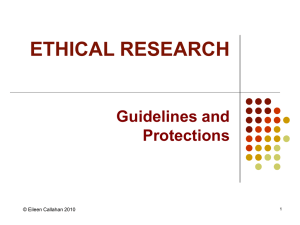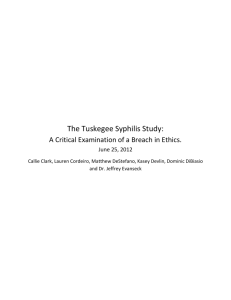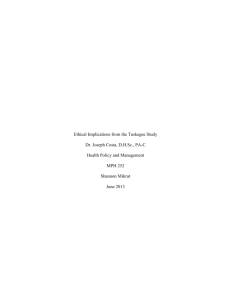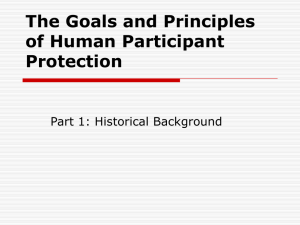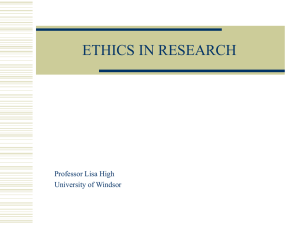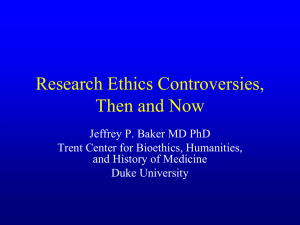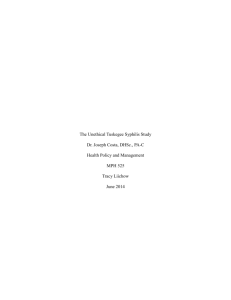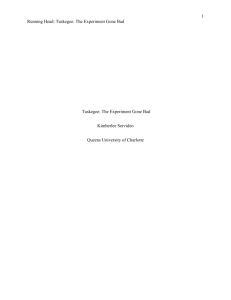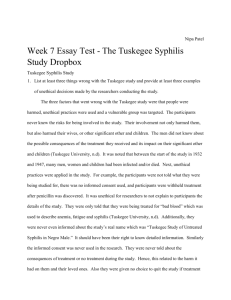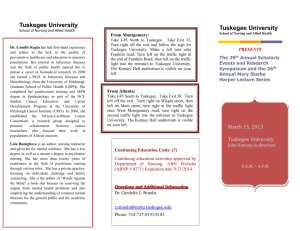Ethical Implications from the Tuskegee Syphilis Study
advertisement
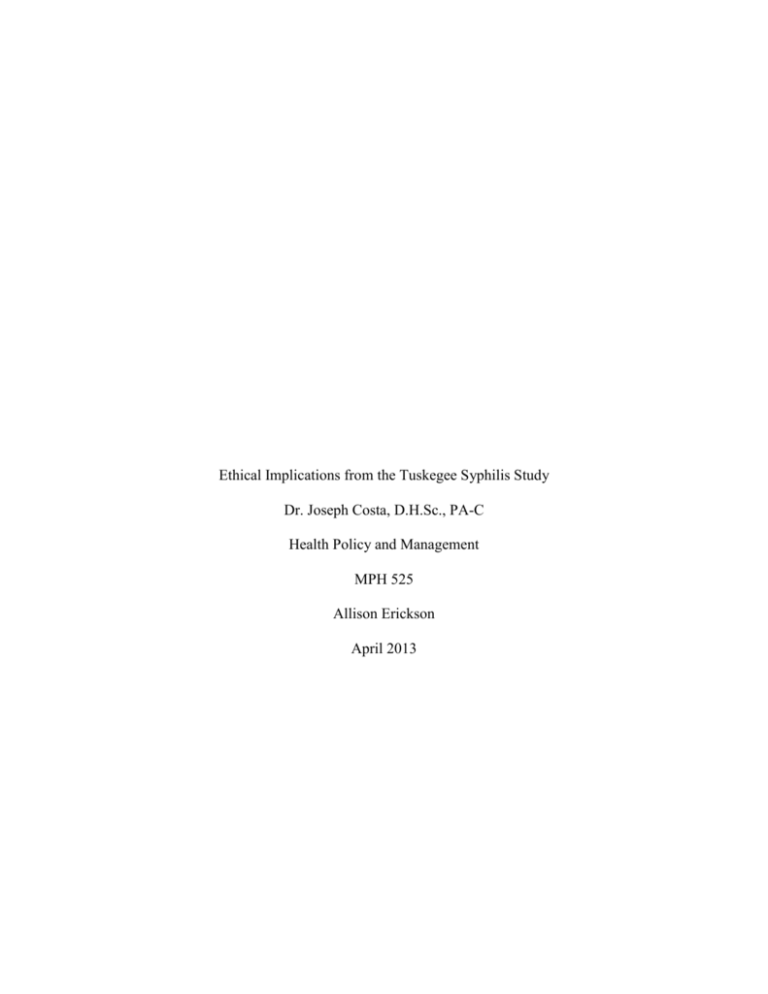
Ethical Implications from the Tuskegee Syphilis Study Dr. Joseph Costa, D.H.Sc., PA-C Health Policy and Management MPH 525 Allison Erickson April 2013 2 Table of Contents Chapter Page 1. Introduction ................................................................................................................................. 4 Ethics and Human Rights ............................................................................................................ 4 General Ideology ..................................................................................................................... 4 Four Principles ......................................................................................................................... 5 2. Tuskegee Syphilis Study ............................................................................................................. 7 Background ................................................................................................................................. 7 Cultural Influence .................................................................................................................... 7 Origins of the Study................................................................................................................. 8 The Study Itself ........................................................................................................................... 9 Selecting Subjects .................................................................................................................... 9 Methods Used ........................................................................................................................ 10 The Results and Implications ................................................................................................ 11 3. Implications of the Tuskegee Study.......................................................................................... 14 Future Repercussions ................................................................................................................ 14 Reduced Trust ........................................................................................................................ 14 Examples of the Mistrust ....................................................................................................... 14 4. Current Ethical Guidelines for Research .................................................................................. 16 Belmont Report ......................................................................................................................... 16 3 Basic Ethical Principles ......................................................................................................... 16 5. Summary ................................................................................................................................... 18 6. Recommendations ..................................................................................................................... 19 References .................................................................................................................................... 21 4 Chapter 1 Introduction Ethics and Human Rights General Ideology The basis of morality, ethics, and human rights began its modern development during the Holocaust and World War II. Events like these were a catalyst for the development of the United Nations. In 1948, the United Nations created the Universal Declaration of Human Rights in which it became an international human rights instrument (Nixon & Forman, 2008). Within this declaration, the rights and freedoms were expanded in the International Covenant on Civil and Political Rights, as well as the International Covenant on Economic, Social and Cultural Rights. In addition to these, there have been over 100 human rights instruments added. “Through these iterations, international human rights have come to be characterized as universal, indivisible, interrelated and interdependent” (Nixon & Forman, 2008). Human rights, internationally, focuses on protecting the dignity, equality, and unalienable rights of all people (Nixon & Forman, 2008). “This focus translates into an abiding attention to the poor, vulnerable and marginalized – those people routinely excluded from the benefits and opportunities of the political, economic and social mainstream” (Nixon & Forman, 2008). Additionally, the philosopher Peter Singer has expressed that all individuals capable of helping other in preventing physical and mental harm, must (Eleftheriadis, 2012). Singer stated his moral principle by saying, If it is in our power to prevent something bad from happening, without thereby sacrificing something of comparable moral importance, we ought to morally do it. By ‘sacrificing something of comparable moral importance’ I mean without causing anything else comparably bad to happen, or doing something that is wrong in itself, or failing to promote some moral good, comparable in significance to the bad thing we can prevent. (Eleftheriadis, 2012, p. 272). 5 This statement made by Singer emphasizes that the distance separating us from other individuals does not become relevant when a moral duty is required. “So he includes that ‘we cannot discriminate against someone merely because he is far away from us” (Eleftheriadis, 2012). Four Principles Judgments, decisions, and actions made by leaders in any field rely on the four principles: Respect for persons, beneficence, nonmaleficence, and justice. Within respect for persons, there are four different elements including autonomy, truth telling, confidentiality, and fidelity. Autonomy “requires that one act toward others in a way that enables them to be self-governing. Basically, this is that right to be left alone” (Burke & Friedman, 2011, p. 91). This can be both a negative and a liberty right. Negative because an individual can refuse treatment, a liberty right because an individual can choose to be free from interference. However, the liberty right of autonomy is inviolable as long as the choice does not interfere with rights of other persons. Burke and Friedman (2011) indicate, “…the law recognizes that individual (liberty) rights cannot be allowed to put society at risk, generally” (p. 91). When pursuing a course of action, individuals need to be rational and uncoerced. Though, when an individual has limited rational thinking from a mental or physical condition that can leave the person without much autonomy. Nonetheless, these individuals are owed respect and provided means for expressing autonomy. In regards to any treatment, autonomy is the underlying factor behind consent for the treatment. The second element of respect for persons is truth telling. Although fairly selfexplanatory, truth-telling requires the honesty of leadership and subordinates. Even if the truth hurts and individual, it must happen. Kantians believe that it is a sign of respect to be truthful. “Loss of trust because of lying would bring into being much more ungood than good” (Burke & Friedman, 2011, p. 91). Thirdly, confidentiality requires that leaders keep secret what has been learned about those being served. However, there are legal requirements that morally justify 6 exceptions to confidentiality. “Ethically (and legally), information can be shared only on a needto-know basis” (Burke & Friedman, 2011, p. 91). Lastly, the fourth element of respect for persons is fidelity, which is the duty one has at keeping one’s word. This element is often times related to promise keeping. As stated by Burke and Friedman (2011), “Keeping one’s promises and being faithful in our relationships and interactions not only treat persons with respect, but further the delivery of services” (p. 91). Beneficence receives its roots from the Hippocratic tradition, “and is defined as acting with charity and kindness” (Burke & Friedman, 2011, p. 91). The balance of benefits and harm is the framework of this principle. Leaders are called to do all that can be done for persons served under beneficence and to act in the best interest of those being served. Nonmaleficence also has roots in medicine and can be defined as doing no harm. Although nonmaleficence allows for specific moral duties and rules, there are some exceptions of doing no harm. For example, with consent, a medical professional may need to inflict harm to avoid more serious harm or would compromise truth telling if the truth would cause more physical and/or mental harm to an individual. Lastly, justice has a plethora of definitions that are personal and collective definitions. “Aristotle defined justice as equals being treated equally, and unequals being treated unequally – a concept common to public policy analysis” (Burke & Friedman, 2011, p. 92). Justice is also defined as fairness. Because of the vast number of definitions, leaders act justly through the application of treating subordinates equally. 7 Chapter 2 Tuskegee Syphilis Study Background Cultural Influence (Note: the words and phrases used in quotations in the following sections do not reflect the views of this author.) At the turn of the 20th Century, American racism had a new rationale provided by Darwinism. “Essentially primitive peoples, it was argued, could not be assimilated into a complex, which civilization. Scientists speculated that in the struggle for survival the Negro in America was doomed” (Brandt, 1978, p. 21). Using census data, social Darwinists predicted the extinction of African Americans throughout the 20th Century, for which it was believed that the African American race would be subject to degenerative evolutionary process. Biologists, anthropologists, and ethnologists supported these findings through the later 19th and early 20th Centuries. Brandt (1978) indicates, “Physicians studying the effects of emancipation on health concluded almost universally that freedom had caused the mental, moral, and physical deterioration of the black population” (p. 21). Dr. W.T. English was quoted saying, “A careful inspection reveals the body of the negro a mass of minor defects and imperfections from the crown of the head to soles of the feet…” (Brandt, 1978, p. 21). Many physicians agreed with English’s analysis by including that the wide nasal openings, receding chins, and projecting jaws left African Americans as one of the lowest species in the Darwinian hierarchy. The sexual nature of African Americans became the central focus in racial differences. One physician noted in the Journal of the American Medical Association that, “The negro springs from a southern race, and as such his sexual appetite is strong; all of his environments stimulate this appetite, and as a general rule his emotional type of religion certainly does not 8 decrease it” (Brandt, 1978, p. 21). The sexual practices of the African American community were deeply scrutinized with southern physicians promoting castration instead of lynching for sexual crimes committed by an African American individual. According to these physicians, lust and immorality, unstable families, and reversion to barbaric tendencies made blacks especially prone to venereal diseases. One doctor estimated that over 50 percent of all Negroes over that age of twenty-five were syphilitic. Virtually free of disease as slaves, they were now overwhelmed by it, according to informed medical opinion. (Brandt, 1978, p. 22). Doctors believed that treatment for diseases like syphilis among the African American population were impossible because in latent stages of infection, symptoms are rather quiet. With quiet symptoms in latent stages, physicians believe that even the most educated African American would not seek treatment for syphilis. Additionally, at the turn of the century many doctors attributed low birth rates, high miscarriage rates, and high crime and insanity rates to syphilis. The configuration of these ideas created a core medical opinion concerning African Americans, sex, and disease in the 20th Century. “Doctors generally discounted socioeconomic explanations of the state of black health, arguing that better medical care could not alter the evolutionary scheme” (Brandt, 1978, p. 22). All of these assumptions created the backdrop for the Tuskegee Syphilis Study. Origins of the Study In 1929, the United States Public Health Service (USPHS) conducted studies rural communities in Southern America exploring the prevalence of syphilis among African Americans the possibility of mass treatment. These studies were under a grant from the Julius Rosenwald Fund. The highest rate of syphilis in a six county radius was in Macon County, Alabama, in which the town of Tuskegee is located. Dr. Taliaferro Clark, the Chief of the USPHS Venereal Disease Division and the author of the Rosenwald Study, concluded that the syphilis conditions in Macon County merited attention. “Clark believed the high prevalence of 9 syphilis offered an ‘unusual opportunity’ for observation. From its inception, the USPHS regarded the Tuskegee Study as a classic ‘study in nature,’ rather than an experiment” (Brandt, 1978, p. 22). The researchers had written no formal protocol for the study, but had the intent of observing how syphilis affected the daily lives of men. Among those advocating for the study was Surgeon General H.S. Cumming. Cumming’s advocacy came from the Oslo Study between 1890 and 1910. The Oslo Study, carried out by Professor C. Boeck at the Oslo Venereal Clinic, intentionally withheld treatment to almost two thousand syphilitic patients. Cumming’s theory was that the treatments available at the time would do more harm than good, therefore, Cumming wanted to research the natural course of syphilis without treatment. According to results from the Oslo Study, 70 percent of the patients went through life without inconvenience from the disease. However, the remaining 30 percent experienced dramatic dangers of syphilis including cardiovascular disease, insanity, and premature death (Brandt, 1978). After the Oslo Study, Dr. J.E. Moore suggested that syphilis should not be allowed to pass untreated. The year that the Tuskegee Study began, in 1932, Moore published a paper with six other syphilis experts that strongly argued for the treatment of syphilis. Therefore, it is believed that the Oslo Study could not have provided justification for the USPHS to perform a study that did not entail the treatment of syphilis (Brandt, 1978). Concluding, “The doctors who devised and directed the Tuskegee Study accepted the mainstream assumptions regarding blacks and venereal disease. The premise that blacks, promiscuous and lustful, would not seek or continue treatment, shaped the study” (Brandt, 1978, p. 23). Leaving room for the lack of treatment seemed natural to the USPHS because many presumed the men would never seek treatment in the first place. The Study Itself Selecting Subjects 10 The basic design of the study called for syphilitic African American individuals between the ages of 25 and 60 years old. Every subject was to receive a full physical examination with xrays and a spinal tap to check for neuro-syphilis. “[The researchers] had no intention of providing treatment for the infected men” (Brandt, 1978). When tasked with collecting subjects for the study, the researchers found it more difficult than anticipated. Therefore, researchers were forced to test large numbers of women and men who did not fit the original qualifications. When the challenges in obtaining subjects for the study grew, Dr. Raymond Vonderlehr found that the only way to obtain willing research subjects was to include the promise of free care. With this offer, many became willing participants. “The USPHS did not tell the men that they were participants in an experiment; on the contrary, the subjects believed they were being treated for ‘bad blood’ – the rural South’s colloquialism for syphilis” (Brandt, 1978, p. 24). To help preserve the subject’s trust and interest, Vonderlehr provided the men with mercurial ointment, knowing full well that it was a noneffective drug. After the USPHS approved continuing the experiment in 1933, Vonderlehr decided it necessary to include a control group. The controls were healthy, uninfected men. Methods Used In all, the study initially involved 600 African American individuals – 399 with syphilis and 201 who did not have the disease (Centers for Disease Control and Prevention (CDC), 2011). The researchers based the experiment on deception. In a letter to the participants about a spinal tap, it stated, “Remember, this is your last chance for special free treatment. Be sure to meet with the nurse” (Brandt, 1978, p. 24). Brandt (1978) indicates further that the, “physicians involved with the study believed that only autopsies could scientifically confirm the findings of the study” (p. 24). To increase the deception, the USPHS hired Eunice Rivers, an African American nurse, to give the men the noneffective medicine with spring tonic and aspirin, as well 11 as follow the men’s health and secure approval for autopsies (Brandt, 1978). “More important, Nurse Rivers provided continuity to the project over the entire forty-year period. By supplying ‘medicinals,” the USPHS was able to continue to deceive the participants, who believed that they were receiving therapy from government doctors” (Brandt, 1978, p. 25). When subjects of the study became severely ill, in order to persuade continued participation, the researches promised to cover burial expenses. During the 40 years of the study, the USPHS sought on several occasions to make sure the subjects did not receive treatment from other sources. Vonderlehr went as far as meeting with groups of African American doctors in Macon County to ask for the cooperation of not providing treatment if study subjects asked for it. The USPHS warned the Alabama Health Department not to treat the test subjects when they took a mobile VD unit into Tuskegee in the early 1940s. In 1941, the Army drafted several subjects and told them to begin antisyphilitic treatment immediately. The USPHS supplied the draft board with a list of 256 names they desired to have excluded from treatment, and the board complied. (Brandt, 1978, p. 25-26). Although Vonderlehr and the USPHS made efforts to ensure the men would not treated, by the early 1950s, many of the men had secured some treatment without the researcher’s knowledge. With the development of penicillin, about 30 percent of the test subjects had received this form of treatment, but about seven and a half percent of those received adequate doses to treat syphilis (Brandt, 1978). The Results and Implications The study continued well into the 1970s, with data and autopsies still being collected. Dr. J. Lawton Smith stated, “You will never have another study like this; take advantage of it” (Brandt, 1978, p. 26) when responding to the debate of whether to continue or end the study. On August 28, 1972, the Department of Health, Education, and Welfare (HEW) formed the 12 Tuskegee Syphilis Study Ad Hoc Advisory Panel in response to the criticism the press’ description of the experiment had created. This panel consisted of nine members, five of which were African American. The focus of the panel was regarding two issues: 1) Was the study justified in 1932 and had the subjects given informed consent? 2) Should penicillin have been provided when it became available in the 1950s? (Brandt, 1978). The group issued the report in June of 1973. By focusing on the issues of penicillin therapy and informed consent, the Final Report and the investigation betrayed a basic misunderstanding of the experiment’s purposes and design. The HEW report implied that the failure to provide penicillin constituted the study’s major ethical misjudgment; implicit was the assumption that no adequate therapy existed prior to penicillin…Indeed there is no evidence that the USPHS ever considered providing penicillin. (Brandt, 1978, p. 26-27). The other focus of the report was on informed consent. Those on the panel declared the experiment ethically unjustified due to failing to obtain the informed consent of the study participants. “The Final Report’s statement, ‘Submitting voluntarily is not informed consent,’ indicated that the panel believed that the men had volunteered for the experiment” (Brandt, 1978, p. 27). However, it is important to note that the National Archives’ records make it clear that the men did not submit voluntarily. The men were told, and believed, that free treatment was being provided by expert government doctors for a serious disease. The Tuskegee Study reveals much about the beliefs within the medical community about the nature of African Americans. The entire health community was jeopardized after the study because of leaving a communicable disease untreated. “There can be little doubt that the Tuskegee researchers regarded their subjects as less than human. As a result, the ethical canons of experimenting on human subjects were completely disregarded” (Brandt, 1978, p. 27). Through the course of the study, there was never any significant protest within the medical 13 community. Additionally, the bureaucratic nature of the government did not seek reassessment of the ethics and scientific value of the Tuskegee experiment. It was the press’ accounts in 1972 that finally created the realization that the study should be discontinued. Brandt (1978) says in finalizing, “In retrospect the Tuskegee Study revealed more about the pathology of racism than it did about the pathology of syphilis; more about the nature of scientific inquiry than the nature of the disease process” (p. 27). Finally, a class-action lawsuit was filed on behalf of the study participants and the families of the participants in the summer of 1973. “In 1974, a $10 million out-of-court settlement was reached. As part of the settlement, the U.S. government promised to give lifetime medical benefits and burial services to all living participants” (CDC, 2011). The Tuskegee Health Benefit Program (THBP) was set up to provide the medical services. In 1975, wives, widows, and children were added to the program and in 1995, the program expanded to include health and medical benefits. According to the CDC (2011), the last study participant passed in January of 2004 and the last widow receiving benefits passed in 2009. Currently, there are 15 children who are receiving medical and health benefits. 14 Chapter 3 Implications of the Tuskegee Study Future Repercussions Reduced Trust The Tuskegee Syphilis Study has become known as one of the most abusive uses of authority on the part of medical researchers. This abuse of authority has left many African Americans skeptical about research participation. Deception, exploitation, and deprivation of treatment in the Tuskegee Study were the root cause of the mistrust that was born from the study. Within weeks of the first press reports of Tuskegee, African American press and leadership began to synonymize the name Tuskegee with the work genocide (Fairchild & Bayer, 1999). Examples of the Mistrust In the mid-1980s, when the AIDS epidemic was becoming more highly recognized, New York City proposed a way of interrupting the spread of the disease through a needle-exchange program. “African American leadership gave voice to their dismay and fury, rooted in suspicions that the failure to provide adequate treatment to drug users represented a form of genocidal neglect” (Fairchild & Bayer, 1999). Political opposition to the needle exchange program came from both law enforcement and the African American community. The 1988 needle exchange program, which was developed by New York City’s health commissioner, was proposed as a small experiment designed to determine whether the innovation could reduce the incidence of HIV infection among users. In denouncing the experiment, Benjamin Ward, the City’s African American Police Commissioner, alluded to the Tuskegee syphilis trials when he explained that his community felt ‘a particular sensitivity to doctors conducting experiments, and they too frequently seem to be conducted against blacks.’” (Fairchild & Bayer, 1999). 15 However, by the mid-1990s, the African American opposition to needle exchange had almost vanished because of the successful results that were becoming apparent. Another example includes studies conductive by health departments, with support from the CDC, to conduct studies of HIV infection in the population by testing blood samples, removing all personal identifiers. Because the samples of blood had no personal identifiers, ethical review boards deemed the study ethical without any problems. “However, anonymization precluded notification of infected individuals” (Fairchild & Bayer, 1999). The criticism this study faced was regarding the informing of individuals if tested positive for HIV, knowing that treatment was available. CDC officials indicated the sole purpose of the study was to detect populations most at risk of developing HIV, not for seeking diagnosis. 16 Chapter 4 Current Ethical Guidelines for Research Belmont Report Basic Ethical Principles The Belmont Report provides ethical principles and guidelines for protecting human research subjects and was developed by the HEW. Many ethical guidelines are similar with the four principles aforementioned. The first basic ethical guideline is respect for persons, in which there are two separate moral requirements: “1) Individuals should be treated as autonomous agents, and 2) Persons with diminished autonomy are entitled to protection” (University of Iowa (UIowa), n.d.). Application of this principle means that subjects, to the degree capable, be given an opportunity to choose what should or should not happen. Within the informed consent process, there are three elements: 1) Information, 2) Comprehension, and 3) Voluntariness. Information means the subject knows, “that the procedure is neither necessary for their care nor perhaps fully understood, can decide whether they wish to participate in the furthering knowledge” (UIowa, n.d.). Comprehension means that the information being conveyed by the researcher is told in a manner and context that can be understood by the participant. However, it may be necessary for the information being presented to be adapted to meet the intellectual needs of the participant. Lastly, voluntariness is the agreement to participate voluntarily, free from coercion and undue influence. The second basic ethical guideline is beneficence. This guideline means that every person involved with a research study is treated in an ethical manner by respecting the decisions of the participants and protection from harm. Also, beneficence means making an effort to secure the well-being of the participants. Two general rules have been formulated around beneficence: 1) Do not harm, 2) Maximize possible benefits and minimize possible harms. When applying this 17 guideline, it is important to determine whether the risks that will be presented to subjects are justifiable risks. The elements of a risk and benefit assessment include the nature and scope of the risks and benefits and the systematic assessment of risks and benefits. Assessment of justifiability of research should reflect at least the following considerations: Brutal or inhuman treatment of human subjects is never morally justified. Risks should be reduced to those necessary to achieve the research objective. When research involves significant risk of serious impairment, review committees should be extraordinarily insistent on the justification of the risk. When vulnerable populations are involved in research, the appropriateness of involving them should itself be demonstrated. Relevant risks and benefits must be thoroughly arrayed in documents and procedures used in the informed consent process. (UIowa, n.d.). Finally, justice means that there is a sense of fairness in distribution with research precipitants. Selecting research subjects must be scrutinized to determine whether the subjects are being systematically selected for reasons directly related to the study at hand. There are two levels of justice relevant to the selection of study participants. First, social justice requires that the can be a distinction drawn between the classes of subjects. It can thus be considered a matter of social justice if there is an order of preference in the selection of classes, like adults before children. Secondly, individual justice requires that the researchers exhibit fairness. “Thus, they should not offer potentially beneficial research only to some patients who are in favor or select only ‘undesirable’ persons for risky research” (UIowa, n.d.). 18 Chapter 5 Summary The premise for basic human rights, especially with research participants, has come from many horrific and unethical practices in the late 1800s and through the middle of the 1900s. Events like the Tuskegee Syphilis Study prompted the need for the development of guidelines that researchers must abide by when conducting studies. The Tuskegee Syphilis Study not only medically deprived African American males from needed treatment, but the researchers actively and knowingly deceived the participants. Many would argue that this study’s implications had much to do with racial pathology and little to do with medical pathology. Culturally, many white individuals saw the African American population as evolutionarily lower than many other humans. Therefore, the Tuskegee Study researchers entered the experiment with preconceived notions about the African American population. After a forty-year period, the American public awakened and realized the inhuman and unethical practice of the Tuskegee Study. From this awakening arose a new standard of guidelines for researchers and participants of a study known as the Belmont Report. Within this report, one will find the proper ways of allowing autonomy, beneficence, and justice in a research model. All three elements open the door for research participants to be treated fairly, with little harm, and with full choice in continued participation. 19 Chapter 6 Recommendations After reviewing the details of the Tuskegee Syphilis Study, this author was shocked to read about the injustice and unethical behaviors of medical professionals less than 40 years ago. There are a number of areas that this author would change about the study. First, the mindset of the researchers needed to change. This author believes that the overarching problem with the study was how the African American individuals were perceived in the first place. However, this author understands that changing cultural viewpoints is certainly not easy. Therefore, the next change that this author would make in how the study was run would be to divide the subjects into different stages syphilis. This author is skeptical that all subjects had the same stage of syphilis as another, so determining the stage would create knowledge of when to begin treatment. That leads this author to the next point in how the real treatment would need to be offered when it became available. In this case when penicillin was shown to be a treatment, it would have needed to be given immediately. Before penicillin was known to be a treatment, the researchers should have made it known to the subjects that the treatments available did not show promising healing aspects, instead showing more negative effects. Lastly, when World War II prompted the drafting of soldiers, this author would allow those being drafted to receive the syphilis treatment from the military. With men going to fight for the country, there is no reason why there would be refusal for medical treatment. Next, informed consent is a vital aspect of research and participation. Individual autonomy requires that researchers respect the choices of the participants. Additionally, researchers are responsible for ensuring the well-being of participants, also known as beneficence. This author believes that the only scenario in which informed consent is not needed is in the case of a life or death situation. For example, if an individual is involved in a serious 20 auto accident and a medical professional seeks to save the individual, that medical professional will not ask the individual if it is okay. Rather, that professional will perform the duties to save the individual’s life. Even if there is harm done to the individual, but the life is saved, that is ethically appropriate. However, in the case of an organized research study, this author does not see any scenario that would dismiss informed consent. This author believes the research studies of today are prized on the informed consent of the participants and should remain such. Lastly, when raising the question about waiving informed consent for some areas of clinical investigation, this author sees a couple problems surfacing. First, this author knows that the legal system has quickly turned into an escape for individuals who feel have been unethically treated. Even if an individual signs a piece of paper acknowledging waiving consent, there can be negative repercussions if something goes wrong. Waiving consent could possibly lead to taking advantage of vulnerable populations, but again, a vulnerable population is in the eyes of the beholder. If a clinical investigation clearly waives consent and an unfortunate event takes place during the investigation, the population being studied could then be seen as vulnerable. All in all, however, this author does not see any waive of consent during clinical study and investigation ethically acceptable. The Belmont Report and Nuremberg Code clearly give the guidelines that must be followed. After reviewing the Nuremberg Code’s history, the Tuskegee Syphilis Study, and the Oslo Study, this author believes there have been too many instances where consent, beneficence, and justice have been overlooked and dismissed. Therefore, this author believes that the research must oblige to the highest standard of treatment of research participants. 21 References Brandt, A.M., (1978). Racism and research: The case of the Tuskegee Syphilis study. The Hastings Center Report 8(6), 21-29. Burke, R.E., & Friedman, L.H., (2011). Essentials of management and leadership in public health (1st ed.). Sudbury, MA: Jones & Bartlett Learning. Centers for Disease Control and Prevention. (2011). The Tuskegee timeline. Retrieved from: www.cdc.gov/tuskegee/timeline.thm Eleftheriadis, P., (2012). A right to health care. Journal of Law, Medicine, & Ethics, 268-285. Fairchild, A.L. & Bayer, R., (1999). Uses and abuses of Tuskegee. Science 284(5416). Nixon, S., & Forman, L., (2008). Exploring synergies between human rights and public health ethics: A whole greater than the sum of its parts. BMC International Health and Human Rights, 8, 1-9. University of Iowa. (n.d.). A summary of the Belmont Report. Retrieved from: http://hso.research.uiowa.edu/print/book/export/html/311
